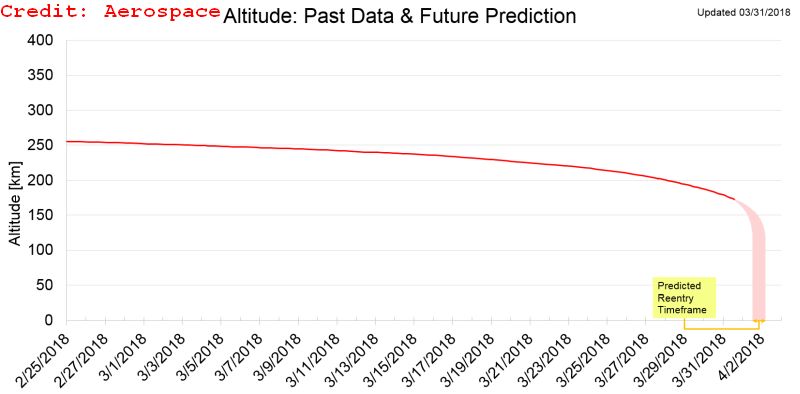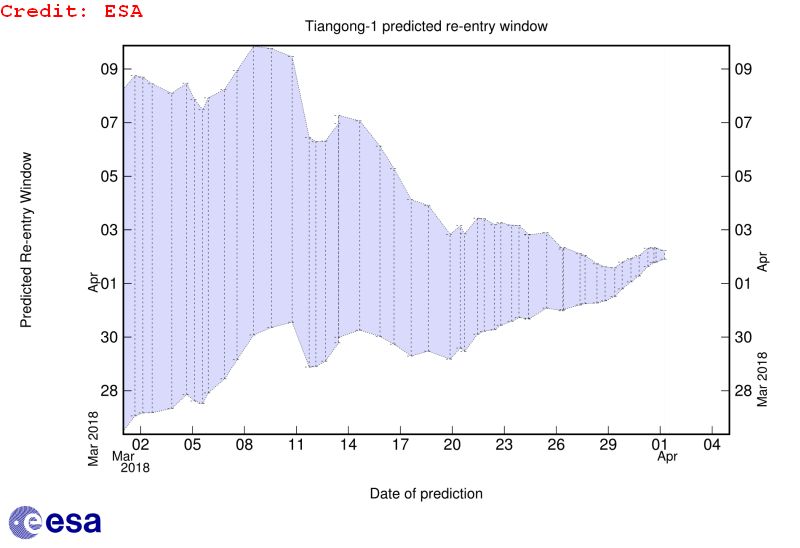You are using an out of date browser. It may not display this or other websites correctly.
You should upgrade or use an alternative browser.
You should upgrade or use an alternative browser.
Russian Progress Spacecraft in trouble!
- Thread starter sToRmR1dR
- Start date
Just an Update on TIANGONG-1. 
Current calculations indicate that Europe may possibly see some debris (in the Heavens), at somewhere between at 43 degrees north and 43 degrees south latitudes, (Portugal, Spain, and the lower border of France and Spain).
SatFlare (Live View)
TIANGONG-1 Decay Predictions and current orbital parameters
http://www.satflare.com/track.asp?q=37820#TOP
WARNING: This object is expected to decay around Sun, 01/04/2018 14:28:00 +/- 12 hours UTC (these predictions are provided by Joseph Remis). (further predictions might be issued later)
Last update: 30 Mar 20:42 UTC
FALLING TIANGONG 1 WHERE IS IT
https://www.youtube.com/watch?v=r6NvMgnzf1k
(Descendinge)
https://youtu.be/diZGl3fBfok?rel=0
Tiangong-1 is plummeting back to Earth
Mar 30, 2018
_https://www.youtube.com/watch?v=H03TzGNPZJY
EARTH — China's Tiangong-1 spacecraft is predicted to fall to Earth on Saturday March 31 or Sunday, April 1. According to Aerospace Corp, re-entry will begin when spacecraft falls to an altitude of 120 kilometers above Earth. Some of this maybe visible from Earth. After reaching an altitude of 80 kilometers, the spacecraft will likely break apart. The UK Space Agency's chief engineer told the BBC that most of Tiangong-1 will burn up on re-entry, with surviving debris likely falling into the ocean. Experts say the risk of it impacting a city or populated area are very low. The chances of someone being hit by Tiangong-1 are 1 in a trillion, reported Space.com, citing Aerospace Corp.

Current calculations indicate that Europe may possibly see some debris (in the Heavens), at somewhere between at 43 degrees north and 43 degrees south latitudes, (Portugal, Spain, and the lower border of France and Spain).
SatFlare (Live View)
TIANGONG-1 Decay Predictions and current orbital parameters
http://www.satflare.com/track.asp?q=37820#TOP
WARNING: This object is expected to decay around Sun, 01/04/2018 14:28:00 +/- 12 hours UTC (these predictions are provided by Joseph Remis). (further predictions might be issued later)
Last update: 30 Mar 20:42 UTC
30-Mar 15:43 UTC - The re-entry date is only 2 days away, however, the spread between the different prediction sources is still unusually large
FALLING TIANGONG 1 WHERE IS IT
https://www.youtube.com/watch?v=r6NvMgnzf1k
(Descendinge)
https://youtu.be/diZGl3fBfok?rel=0
Tiangong-1 is plummeting back to Earth
Mar 30, 2018
_https://www.youtube.com/watch?v=H03TzGNPZJY
EARTH — China's Tiangong-1 spacecraft is predicted to fall to Earth on Saturday March 31 or Sunday, April 1. According to Aerospace Corp, re-entry will begin when spacecraft falls to an altitude of 120 kilometers above Earth. Some of this maybe visible from Earth. After reaching an altitude of 80 kilometers, the spacecraft will likely break apart. The UK Space Agency's chief engineer told the BBC that most of Tiangong-1 will burn up on re-entry, with surviving debris likely falling into the ocean. Experts say the risk of it impacting a city or populated area are very low. The chances of someone being hit by Tiangong-1 are 1 in a trillion, reported Space.com, citing Aerospace Corp.
Chinese Space Station Tiangong-1 May Fall to Earth Later Than Expected
Fri, 30 Mar 2018 21:24:00 (Live Tracking) Links Within:
_https://www.n2yo.com/satellite-article/Chinese-Space-Station-Tiangong1-May-Fall-to-Earth-Later-Than-Expected/21
Tiangong-1 space station reentry
https://www.n2yo.com/info/?a=61


Published on Apr 1, 2018 (Thierry Legault)
Tiangong (altitude 165 km) exits the shadow of the Earth below Jupiter and passes just between Mars and Saturn in the dawn sky of France (Cévennes). Sony alpha 7S & Sigma Art 35mm f/1.4.
https://youtu.be/L04sEG0fJmc?rel=0
Fri, 30 Mar 2018 21:24:00 (Live Tracking) Links Within:
_https://www.n2yo.com/satellite-article/Chinese-Space-Station-Tiangong1-May-Fall-to-Earth-Later-Than-Expected/21
Update for 6 p.m. EDT: Tiangong-1 is now forecast to re-enter Earth's atmosphere on April 1 at 12:15 p.m. EDT (1615 GMT), give or take 9 hours, according to the Aerospace Corp.
Original story: A doomed Chinese space station will fall to Earth later than expected due to changes in the sun's predicted activity, the European Space Agency's (ESA's) Space Debris Office in Germany predicted.
An updated ESA forecast issued today (March 30) said the 8.5-metric-ton (9.4 tons) space lab will fall to Earth later in the day on April 1. That's because the sun's activity is weaker than expected, ESA explained.
Tiangong-1's orbit takes the station very close to Earth's atmosphere right now. When the sun is more active, charged particles from the solar wind hit Earth's atmosphere, ESA officials said. These particles make Earth's gases balloon farther into space, increasing the gas density at higher altitudes. These gases, in turn, affect the drag Tiangong-1 experiences as it circles the Earth. [In Photos: China's Tiangong-1 Space Station]
The stronger the drag, the faster Tiangong-1 will fall. However, because the sun's activity is weaker than predicted, the atmosphere didn't balloon as much. Tiangong-1 will therefore experience less drag and descend more slowly than expected, ESA said.
"A high-speed stream of particles from the sun, which was expected to reach Earth and influence our planet's geomagnetic field, did, in fact, not have any effect, and calmer space weather around Earth and its atmosphere is now expected in the coming days," ESA officials said in the forecast.
"This means that the density of the upper atmosphere, through which Tiangong-1 is moving, did not increase as predicted (which would have dragged the spacecraft down sooner), and hence the ESA Space Debris Office has adjusted the predicted decay rate."
ESA emphasized that the re-entry window is still variable and uncertain. When the school-bus-size space station does fall, it will descend somewhere between 43 degrees north and 43 degrees south latitudes, underneath its current orbital inclination. This path includes many populated parts of the world, including the United States.
The station's unpredictable fall has attracted attention around the world, along with worries that space debris might crash into structures or people below. Under a United Nations treaty, liability would likely rest with China. That said, the chances of someone getting hit are infinitesimally small; you have a far better chance of winning the Powerball jackpot.
Harvard University astrophysicist Jonathan McDowell told Space.com's sister site Live Science that he predicts only 220 to 440 lbs. (100 to 200 kilograms) of debris from Tiangong-1 will make it to the planet's surface. Still, the space station will put on a spectacular show as it falls, he said.
"Fireballs are almost certain," said McDowell, a frequent commenter on Tiangong-1's descent who also works on NASA's Chandra X-ray Observatory. "What happens is that there are some dense sections of the lab connected together by a rather thin structure," McDowell added, explaining how the fireballs are generated. "The thin structure melts first, turning the lab into a bunch — a few to a few dozen, depending — of independent pieces which melt and burn more slowly — fireballs."
There are many past examples of satellites or space stations falling uncontrollably to Earth and generating space debris. Perhaps the most famous one is Skylab, a former NASA space station that dropped large pieces in rural Australia in 1979 as it fell. Skylab, however, was a much larger structure. Its mass came in at about 100 tons (90.7 metric tons), or about 10 times more massive than Tiangong-1.
Tiangong-1 was the first Chinese space station. After its launch in 2011, two crews of taikonauts (Chinese astronauts) visited the station, in 2012 and 2013. China remained in communication with Tiangong-1 until 2016. Since then, the station has been dropping slowly toward Earth for an inevitable, deadly (to the spacecraft) encounter with the atmosphere. China also has an active successor space station in orbit, called Tiangong-2, that launched in 2016.
Tiangong-1 space station reentry
https://www.n2yo.com/info/?a=61

Only from one day before the actual reentry will it become possible to roughly predict which ground tracks, and hence which regions on Earth, might witness the reentry. However even then, an impact location prediction on the order kilometres is, for an uncontrolled reentry, beyond current technical capabilities due to complexities of modelling the atmosphere, the dynamics of the reentering object and limitations in observing the spacecraft.
In general, the uncertainty associated with an uncontrolled reentry prediction is on the order of 20% of the remaining orbital lifetime. Practically, this means that even 7 hours before the actual reentry, the uncertainty on the break-up location is a full orbital revolution – meaning plus or minus thousands of kilometers.
The live tracking is the output of a celestial mechanics model implementation using as input the orbital (keplerian) elements collected from various sources. For Tiangong-1 the orbital elements are distributed by Defense Joint Space Operations Center (JSpOC). Tracking prediction is highly unreliable typically hours before the reentry due to many uncertain parameters involved in this process.

Published on Apr 1, 2018 (Thierry Legault)
Tiangong (altitude 165 km) exits the shadow of the Earth below Jupiter and passes just between Mars and Saturn in the dawn sky of France (Cévennes). Sony alpha 7S & Sigma Art 35mm f/1.4.
https://youtu.be/L04sEG0fJmc?rel=0
